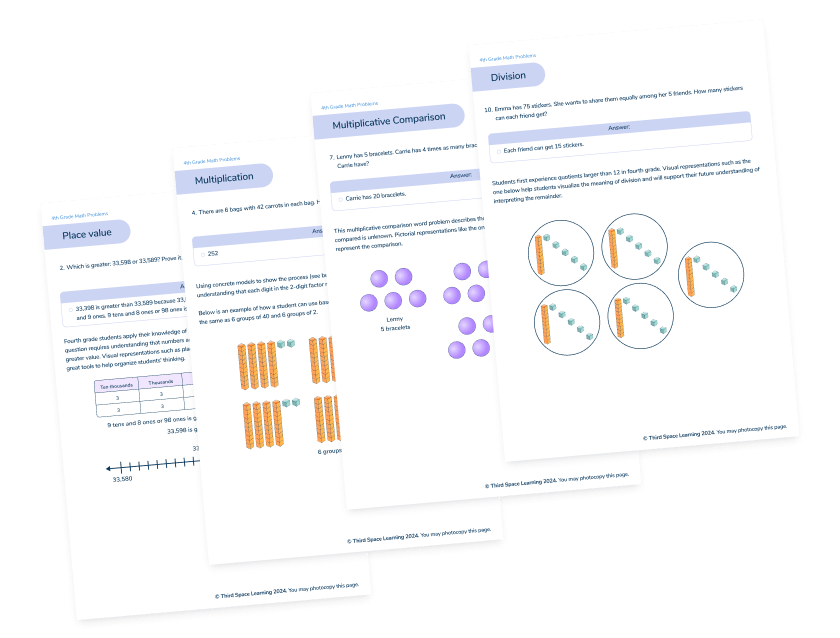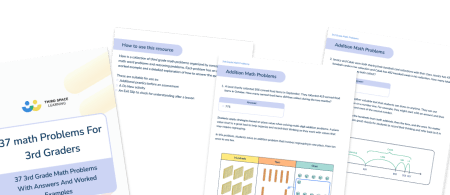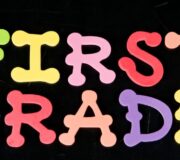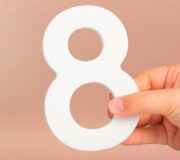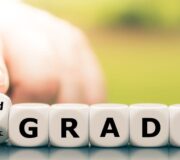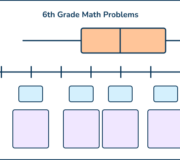37 Math Problems For 3rd Graders: Answers With Worked Examples
3rd grade math problems formally introduce 3rd graders to math skills such as multiplication, division, and fractions. They build on learners’ conceptual understanding of partitioning shapes and using repeated addition with concrete models, drawings, and expressions, learned in previous grades, to make connections using symbols, letters for unknown numbers, and equations.
In this blog, we look closely at the essential math skills a third grader needs to know and provide math problems, worked examples, and teaching tips, to help teachers and educators support their third-grade students in mathematics.
What are math problems for 3rd graders?
3rd grade math problems are specific math problems suitable for 8-9 year olds. They include the following math concepts:
- Addition
- Subtraction
- Multiplication
- Division
- Fractions
- Place Value
- Measurement and Data
- Geometrical Shapes
37 3rd Grade Math Problems
37 3rd grade math problems and answer key for students to solidify understanding of math concepts. Questions cover addition, subtraction, multiplication, division, rounding, fractions, time, data, area, perimeter and geometry.
Download Free Now!Benefits of math problems for 3rd graders
3rd graders can use these math problems to build on their prior knowledge of addition and subtraction developed in Kindergarten, 1st and 2nd grade.
The math concept of repeated addition, learned in 2nd grade, directly links to their understanding of multiplication through models learned in the 3rd grade such as equal groups and arrays.
Many 3rd grade math concepts they focus on strengthen their foundation in fraction concepts and set them up for success with fraction operations explored in 4th grade and 5th grade.
Word problems help students make connections between representations and develop students understanding of the relationship between addition and subtraction or multiplication and division.
Multiplication word problems are just one example of word problems used to deepen students’ understanding of each operation. Educators should incorporate word problems through all phases of teaching each concept, not just near the end of a unit when learners appear ready to “apply” their learning.
3rd grade math curriculum
The topics focused on in third-grade math include:
- Addition within 1,000
- Subtraction within 1,000
- Whole number multiplication
- Whole number division
- Understanding fractions
- Rounding to the nearest 10 or 100
- Elapsed time
- Representing and Interpreting Data
- Describing Quadrilaterals
How the 3rd grade math curriculum fits into learners’ math development
3rd grade students extend their 2nd grade knowledge of adding and subtracting within 100 to include adding and subtracting within 1,000 using place value strategies and properties of operations.
Learners continue to build on equal sharing from 1st grade and learn about unit fractions and the meaning of the numerator and denominator. This sets them up for success with fraction operations in 4th and 5th grade.
Common challenges teaching third graders
As 3rd graders use all four operations, a common challenge for some is mixing up which operation to use when problem solving. They may focus on one word in a word problem instead of considering the entire problem.
Concrete models and representations can help students work through problems by showing the actions happening in a problem situation. However, as they get older, some students may also want to reduce their use of math manipulatives to build concrete models or draw pictures to show their thinking leaving room for error.
Teach students to visually show their thinking through models or pictures, or express it with words and numbers instead of keeping it in their head.
Math problems for 3rd graders with answers
Here are 34 math problems for 3rd graders organized by topic, including:
- Addition
- Subtraction
- Fractions
- Time
- Data
- Area
- Perimeter
- Geometry
Addition math problems for 3rd graders
In 3rd grade, students build on addition skills from K-2nd grade and are expected to add fluently within 1,000. This can include one-digit numbers, two-digit numbers and three-digit numbers.
Question 1
A local charity collected 356 canned food items in September. They collected 419 canned food items in October. How many canned food items did they collect during the two months?
Answer: 775
Students apply strategies based on place value when solving multi-digit addition problems. A place value chart is a great tool to help organize and record their thinking as they work with values that may require regrouping.
In this problem, students solve an addition problem that involves regrouping in one place, from ten ones to one ten.
Question 2
Jessica and Caleb were both sharing their baseball card collections with their class. Jessica has 435 baseball cards in her collection and Caleb has 482 baseball cards in his collection. How many total baseball cards did they both collect?
Answer: 917
An open number line is another valuable tool that students can draw on anytime. They can use multiple addition strategies on a number line. For example, they might start with an amount and then add on the hundreds, tens and ones of the second number.
Another strategy is adding the hundreds from both addends, then the tens, and the ones. No matter the strategy, number lines are great visuals for students to record their thinking and refer back to it in their explanations.
Question 3
Sabrina had 267 beads to use for making bracelets. Her mom bought her a new pack of 135 beads. How many beads does Sabrina have now?
Answer: 402 beads
This problem requires regrouping of ones to tens, and tens to hundreds. Students should have experience regrouping in one or more places when adding within 1,000.
The partial sum strategy helps set the foundation for using an algorithm in fourth grade to add greater multi-digit numbers.
Subtraction math problems for 3rd graders
As with addition, students build on their subtraction knowledge from K-2nd grade and use single-digit subtraction and subtracting 2-digit numbers within 100 to develop fluency in subtracting within 1,000. This can include up to 3-digit numbers.
Although students have used subtraction since Kindergarten, it can still be difficult for many students. Providing students with multiple strategies and methods for solving with subtraction allows them to choose the most efficient method move towards fluency, which includes:
- Efficiency
- Accuracy
- Precision
Question 4
283 guests were waiting to ride a ferry boat to get to the entrance of a theme park across the lake. Only 155 guests can ride the ferry boat at a time. How many guests will have to wait for the next ferry boat to arrive?
Answer: 128 guests
When completing subtraction word problems, make connections between strategies students use to add within 1,000 and subtract within 1,000. This strengthens their understanding of the relationship between addition and subtraction, and place value.
Similarly to addition, students can use a place value chart to help them with regrouping when subtracting 2 or 3-digit numbers. In this problem, students need to regroup 1 ten for 10 ones.
Question 5
Andrew and his family drove 607 miles to get to their hotel. They made one stop after driving for 312 miles. How many more miles did they have to drive to get to the hotel?
Answer: 295
Using a number line to subtract, or count back, may confuse some students. Remind students to use strategies that make sense to them. They may start with one number and subtract the hundreds, tens, and then ones of the second number.
Some students prefer to subtract using place value, while others subtract until they get to a multiple of 10 and continue subtracting from there.

Question 6
Josie had $168 at the beginning of the week. She spent $27 at the mall on Tuesday. She worked on Thursday and earned some money. She ended the week with $195. How much money did she earn on Thursday?
Answer: $54
This problem includes both addition and subtraction and provides an opportunity for students to write an equation using a letter as the unknown value. Students can use the relationship between addition and subtraction to determine what the letter represents.
168 – 27 + s = 195
141 + s = 195
195 – 141 = s
54 = s
Multiplication math problems for 3rd graders
Many third-grade standards group multiplication and division together. When students are officially introduced to both operations, typically multiplication is first.
Learners develop an understanding of multiplication using concrete models, pictures, and equations when solving word problems.
In 3rd grade, they solve word problems that lend themselves to making equal groups, arrays, or finding the area as a measurement.
Other multiplication concepts that 3rd grade students will explore include:
- Properties of operations
- Finding an unknown product
- Solving one or two-step word problems that involve more than one operation
Question 7
There are 8 dry-erase markers in one pack. How many dry-erase markers are in 3 packs?
Answer: 24
3rd graders explore equal groups. They can do this using an array. Students must understand that the one factor is the number of groups and the other is the number in each group.
For example, 3 x 8 can be represented using the following array:

Question 8
Find the product of 5 x 3 x 4
Answer: 60
Learners explore associative property in 3rd grade as well as commutative property and distributive property.
When evaluating multiplication expressions with three or more factors, students learn that the way they group the factors to multiply does not change the value of the product.
Encourage students to start with the two factors that seem the friendliest to multiply, but to also keep in mind how confident they will feel when multiplying the product of those two factors with the next factor in the expression.
Other properties of multiplication that students will explore in 3rd grade include the:
- commutative property
- distributive property
- identity property
- zero property
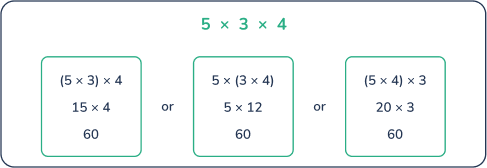
Question 9
Find the product of 7 x 40.
Answer: 280
7 x 40 = 7 x 4 tens
7 x 4 tens = 28 tens
28 tens = 280
7 x 40 = 280
Question 10
The school music teacher set up his classroom for an after-school chorus rehearsal. He formed 3 rows with 12 chairs in each row. How many chairs are in the classroom in total?
Answer: 36 chairs
Allow students to choose their method, whether it’s using manipulatives or drawing pictures to represent the information in word problems.
Ask them where they see each value in their concrete model or picture.

Division math problems for 3rd graders
Many multiplication strategies are closely related to division problem strategies. Third graders must understand the relationship between multiplication and division to use it as a strategy for problem-solving. This helps with math problems that involve finding an unknown.
Third graders learn to write a blank, question mark, or letter when there is an unknown product, quotient, or factor. This aids them when writing a related equation using a known math fact with an operation they are comfortable with.
Question 11
Zoe has 42 stickers. She wants to give 7 stickers to each of her friends at her birthday party. How many friends are at her birthday party?
Answer: 6 friends
Once students begin working with division, they tend to focus on specific keywords such as “each” and think that the problem represents multiplication. Students must model the actions of what is happening in the problem. Giving the same amount out multiple times will highlight the division and sharing equal amounts.
Encourage students to build and draw models to show their thinking. Ask them to explain their strategy to you, a partner, or the class for solving division word problems such as this one.
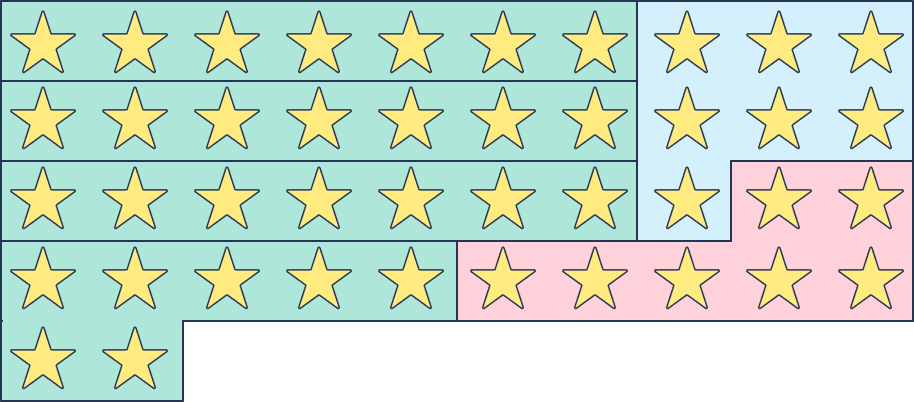
Question 12
There are 3 boxes on each shelf in the backroom of a bookstore. 36 new boxes were delivered and must be placed on the 4 shelves. How many total boxes are on each shelf?
Answer: 12
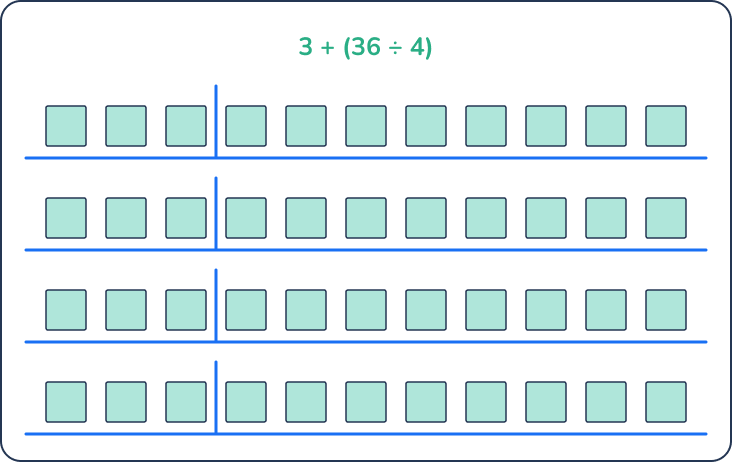
Extend students’ understanding of multiplication and division by pairing multiplication and division together, or with addition or subtraction. This enables students to solve two-step problems represented as an expression or equation.
Follow-up discussions to help students understand which operation they should solve first to set them up for success with the order of operations in fifth grade and beyond.
Question 13
George ran 63 miles last week. If he ran every day last week, how many miles did he run each day?
Answer: 9 miles
Writing an equation to represent math word problems supports learners’ understanding of the relationship between multiplication and division.
When learners write a division equation using a letter or question mark for the unknown number, they can rewrite the expression as a multiplication expression if they aren’t confident with division facts.
A familiar multiplication equation may lead third graders to use mental math once they’re fluent with multiplication facts.
63 ➗7 = m
7 x m = 63
7 x 9 = 63
Question 14
Determine what the ? represents in the equation. 48 6 = ?
Answer: 8
48 ➗ 6 = ?
6 x ? = 48
6 x 8 = 48
Rounding math problems for 3rd graders
The third place value concept covered in third grade is rounding. Third-grade math requires students to use their place value understanding to round whole numbers to the nearest 10 or 100.
Understanding the value of digits in a number is important when rounding because it helps to determine which 10 or 100 a whole number is closest to.
Question 15
Round 27 to the nearest 10.
Answer: 30
Using a number line with a midpoint and two endpoints helps students visualize which tens or hundreds a whole number falls between.
Although number lines are not required to be used as a strategy in 3rd grade, they can be used to help students develop their rounding skills conceptually.

Question 16
Round 639 to the nearest 100
Answer: 600

Question 17
Round 450 to the nearest 100
Answer: 500
In some instances, a value is directly in the middle of the tens or hundreds. However, learners should know that if the digit being rounded is 5 or larger, then it must round up. 4 or less and the digit rounds down.

Fraction math problems for 3rd graders
Students build on their fraction knowledge form 1st and 2nd grade, including:
- Partitioning shapes into equal shares by exploring unit fractions
- The meaning of the numerator and the denominator
3rd graders should have plenty of opportunities to represent fractions by building concrete models and drawing pictures before they are required to write fraction notations.
Using fraction vocabulary such as halves, thirds, fourths, parts and parts of a whole helps students make sense of fractions as part of a number before writing the numerator above the denominator with a fraction bar in between.
Facilitate discussions involving unit fractions and how the non-unit fractions are the sum of multiple unit fractions.
Question 18
Represent the fraction \frac{3}{4} by drawing a model.
Answer:
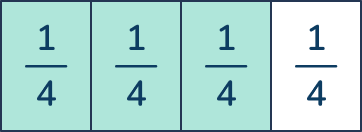
Question 19
Count the parts and label each tick mark on the number line:
\frac{1}{8}, \frac{2}{8}, \frac{3}{8}, \frac{4}{8}, \frac{5}{8}, \frac{6}{8}, \frac{7}{8}, \frac{8}{8}
Answer:

Discuss with students that the intervals or spaces between the tick marks represent the distance from one tick mark to the next tick mark or a unit fraction such as \frac{1}{8}.
The distance from zero to that point or tick mark is a different value labeled with a specific fractional value, such as \frac{5}{8}.
Fraction problems for 3rd graders
Question 20
Select the equivalent models.
Answer: C and E
Equivalent fractions in third grade focus on visual models preparing them to explore finding equivalent fractions through operations in the fourth grade.
Question 21
Which is greater, \frac{4}{8} or \frac{4}{6}? Write a comparison statement using the symbols >, =, or <.
Answer: \frac{4}{8} < \frac{4}{6}
Time math problems for 3rd graders
In third-grade math, students learn to tell time to the nearest minute on digital and analog clocks.
They use their understanding of time to determine an elapsed time when given a start and stop time for an event or sequence of activities.
Students explore using number lines to help them understand elapsed time word problems. These can include:
- Start and stop time given, elapsed time unknown
- Start and elapsed time given, stop time unknown
- Elapsed time and stop time given, start time unknown
Question 22
Represent the time shown on the digital clock by drawing on the analog clock.
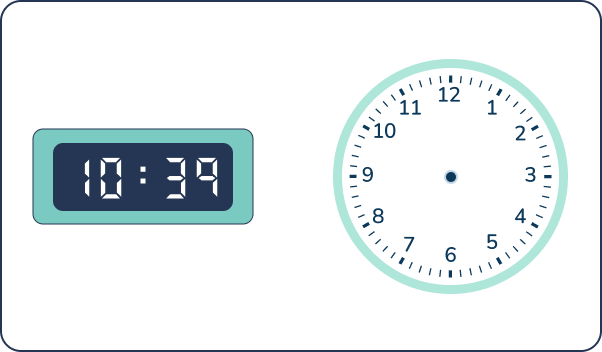
Answer:
Question 23
It is 10:50 a.m. and lunch begins in 15 minutes. What time will it be? Use the number line to show the time.
Answer: 11:05 a.m.
Students should use the number line to determine time in a way that makes sense.
Question 24
On Saturday, Angela left the park at 2:45 p.m. where she attended soccer practice for 75 minutes. What time did Soccer practice begin?
Answer: 1:30 p.m.
Working backwards to determine a time may seem challenging for some students. They may use a number line to subtract whole numbers.
Pay attention to how students maneuver counting back in time from the 1 o’clock hour into the 12 o’clock or morning time.
Data math problems for 3rd graders
Third-grade math develops the concept of collecting and representing data from previous grades. Students must:
- Ask and answer questions
- Ceate tally charts
- Draw picture graphs and bar graphs
- Learn about line plots
In third grade, students use larger values and scales to represent their data than in previous grades. They also answer one and two-step word problems about information presented in graphs.
Question 25
How many more cloudy days were there than rainy days in March?
Answer: 5 days
In grade 3, students create and read graphs with scales greater than 1. If they struggle to interpret the information on a bar or picture graph, they can add tick marks between the intervals to count accurately.
Question 26
The students in Mrs. Campbell’s class voted on which animal should be their class mascot. The votes are shown on the graph.
How many fewer students voted for an animal that lives in the ocean than an animal that lives on land?
Answer: 4 students
(8 + 6) – 10= 4
Provide students with opportunities to solve one and two-step problems involving a picture or bar graph.
Problems should relate directly to “How many more?” and “How many less?” questions.
Question 27
What is the length of the pencil measured to the nearest half or quarter of an inch?
Answer: 6 \frac{1}{2} inches
3rd grade students explore measuring objects with a ruler marked with halves and fourths of an inch. Examples like this bring math into real-life scenarios for working with fraction values. Students can see and hear how the terms fourths and quarters are used interchangeably regarding measurement.
Question 28
Create a line graph to display the collected data.
| Paper clip | 1 in. | Dry-erase marker | 4 \frac{1}{2} in. |
| highlighter | 5 \frac{1}{2} in. | scissors | 5 in. |
| smartphone | 6 \frac{1}{2} in. | Index card | 5 in. |
| notebook | 9 \frac{1}{2} in. | battery | 1 \frac{1}{2} in. |
| pen | 6 in. | gluestick | 3 in. |
Answer:

Students are introduced to line plots with whole number units in the 2nd grade. In the 3rd grade, students measure units to the nearest half or fourth and record the measurement of objects on line plots.
They extend their understanding of representing information on a line plot in 4th and 5th grade where they solve problems involving fraction operations.
Area math problems for 3rd graders
Students apply their understanding of multiplication and division while exploring the area of two-dimensional shapes. Area is an attribute of 2-D shapes and multiple strategies can be used to find it.
Question 29
Find the area of the rectangle.
Answer: 48 square units
Question 30
Jillian has a new painting to hang in her bedroom. The side lengths of the painting are 7 in. and 4 in. What is the area of the painting?
Answer: 28 square inches
Students must understand that counting the number of tiles arranged as an array is the same as multiplying two of the given side lengths for a rectangle.
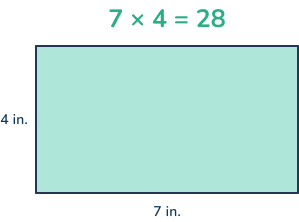
Question 31
Find the total area of the figure.
Answer: 10 square inches
(2 x 2) + (4 x 1)
4 + 4
8
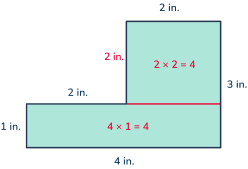
Learners apply their understanding of area to determine the area of rectilinear figures: figures composed of more than one rectangle.
A common misconception for some students is to multiply all of the side lengths. This is a great opportunity to relate the area to the distributive property by decomposing the figure into two separate rectangles. Then they can determine the area of each rectangle and add the two values together to find the total area.
Perimeter math problems for 3rd graders
3rd graders explore the perimeter of shape, how to work it out and how it differs from the area.
A common misconception for third graders, that sometimes carries on into fourth grade and fifth grade, is mixing up area and perimeter. Take the time to allow students to explore and discuss examples and non-examples of area and perimeter in the real world and around the classroom.
Question 32
Find the perimeter of the bulletin board.
Answer: 160 inches
Students need to add all of the side lengths together:
45 + 45 + 35 +35 = 160
Question 33
The school garden has one side length of 13 feet. The perimeter of the garden is 40 feet. How long is the other side length?
Answer: 7 feet
13 + 13 + s + s = 40
(2 x 13) + (2 x s) = 40
26 + (2 x s) = 40
40 – 26 = 2 x s
14 = 2 x s
14 ÷ 2 = s
7 = s
Question 34
- Which rectangles have the same perimeters but different areas?
- Which rectangles have the same area but different perimeters?
Answer:
- Rectangles 3 and 4 have the same perimeters and different areas.
- Rectangles 2 and 3 have the same area and different perimeters.
Reminder students the perimeter is the distance around the outside of a shape or object and the area is the number of square units needed to cover the space of the shape or object.
Rectangle 1: side length = 2, side length = 12
Perimeter: 12 + 12 + 2 + 2 = 28
Area: 2 x 12 = 24
Rectangle 2: side length = 6, side length = 6
Perimeter: 6 + 6 + 6 + 6 = 24
Area: 6 x 6 = 36
Rectangle 3: side length = 4, side length = 9
Perimeter: 9 + 9 + 4 + 4 = 26
Area: 4 x 9 = 36
Rectangle 4: side length = 6, side length = 7
Perimeter: 6 + 6 + 7 + 7 = 26
Area: 6 x 7 = 42
Geometry problems for 3rd graders
Describing, analyzing, and comparing properties of 2D shapes is one of the main concepts of geometry in third-grade math.
3rd graders must determine whether shapes are considered quadrilaterals from the number of their sides. They describe and draw examples of specific quadrilaterals such as a rectangle and a rhombus and sort shapes according to their sides, angles, and other characteristics.
This sets a foundation for further investigation of quadrilaterals and triangles in fourth grade and fifth grade where they learn about the hierarchy of quadrilaterals.
Question 35
How many of the shapes are quadrilaterals?
Answer: 5 are quadrilaterals
Provide printouts of the shapes and allow students to cut and sort the shapes into groups such as quadrilaterals or non-quadrilaterals.
Students may also draw a circle around shapes with four sides.
Question 36
Count and record the number of quadrilaterals with:
- 0 pairs of parallel sides
- 1 pair of parallel sides
- 2 pairs of parallel sides
Answer:
0 parallel sides
1 pair of parallel sides
2 pairs of parallel sides
Question 37
Draw the following 2D shapes:
- Rectangle
- Rhombus
- Square
- A quadrilateral that is not a parallelogram or trapezoids.
Answer:
a)
b)
c)
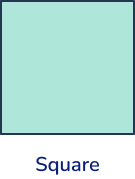
d)
Possible extension: ask students to explain why the shape they have drawn is an example of that specific shape.
3 top tips for teaching math problems to 3rd graders
- When exploring multiplication and division concepts, provide multiple opportunities for students to make connections between models, representations, and equations.
Present learners with real-life word problems. Have students use math manipulatives to build concrete models and draw pictures that represent their model and the word problem.
Next, ask them to write an equation representing the word problem and their models.
Last, prompt students to explain how all three pieces of their work represent the word problem and how they used each to solve the problem. - Remember the CRA model: Concrete, Representation, Abstract.
Understanding multiplication, division, and fractions starts at the concrete phase in 3rd grade, moves into the representation phase, and has many opportunities for the abstract phase.
Other skills such as fluently adding and subtracting within 1,000 focus on the representation and abstract phases. There may be some students who need more time in the concrete phase, using manipulatives while others may be more comfortable with drawing pictures and number lines or using the relationship between addition and subtraction as their strategies.
Students should always use strategies and models that make sense to them.
- Teach multiplication facts using positive experiences. Avoid focusing on memorization drill worksheets and multiplication tables. Instead provide opportunities to practice in meaningful ways using games, real-world problems, partner and group discussions, and reasoning with manipulatives.
How can Third Space Learning help with 3rd grade math?
Build math confidence early on with Skye, the elementary AI math tutor built by teachers. Tutoring follows an “I do, we do, you do” structure to scaffold learning and promote progress. Skye functions by talking learners through math problems; speaking, listening, and giving explanations and tailored guidance to help them solve them at their own pace.
Skye has been specifically trained to use our curriculum of elementary math lessons, with a range of standards-aligned programs available, to teach math to address learning gaps, boost math knowledge, build problem-solving skills, deepen understanding, develop confidence and boost progress.
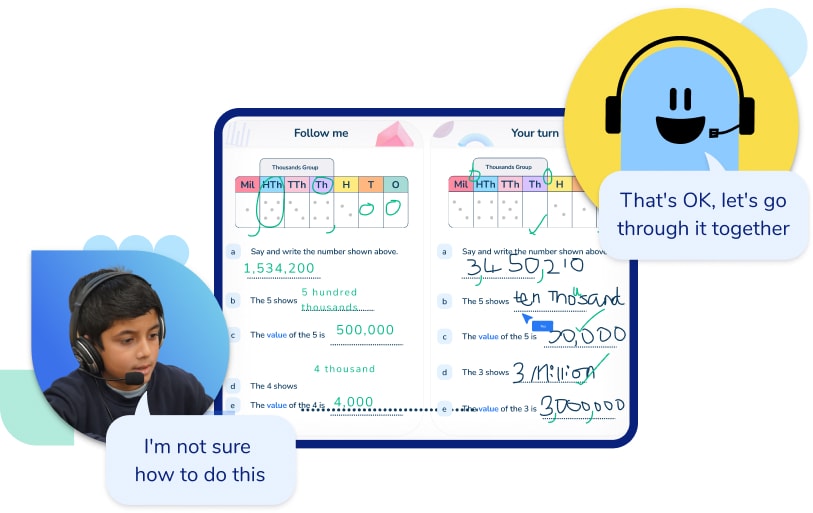
3rd grade math worksheets and resources
Looking for more resources? Check out our math games and selection of second grade addition and subtraction worksheets, posters and activities covering the key 3rd grade math topics and more:
- 3rd Grade Fractions Error Analysis
- 3rd Grade Addition And Subtraction Code Crackers
- 3rd Grade Place Value and Rounding Word Problems
- 3rd Grade CCSS Practice Test
Frequently asked questions
What math should 3rd graders be doing?
Learners in 3rd grade will spend most of the year building their conceptual understanding of major math skills and concepts such as representing and solving problems involving multiplication and division and developing an understanding of fractions as numbers. They also spend time solving problems about measurement that include time, liquid volume, and finding the area and perimeter of a rectangle.
What are the topics in mathematics in grade 3?
Topics in mathematics in grade 3 include: Representing and solving problems involving multiplication and division Properties of multiplication The relationship between multiplication and division Multiplying and dividing within 100 Patterns in arithmetic Adding and subtracting within 1,000 Understanding fractions as numbers Problem-solving and estimating intervals of time, liquid volumes, and masses of objects Picture graphs, bar graphs, and line plots Area and perimeter Reasoning with shapes and their attributes
What are math facts for 3rd grade?
In third-grade math, learners will fluently multiply and divide within 100 using strategies. While exploring the relationship between multiplication and division, learners will begin to use one operation to help them solve the other operation, such as using 6 x 9 = 54 to help know 54 6 = 9. Although 3rd graders will spend most of their time working with multiplication and division simultaneously, there is an expectation that learners will know from memory all products of two one-digit numbers. Multiplication facts, one of the math facts learners will explore and commit to memory during the elementary grades, are important for 3rd graders to end the year knowing so that they are set up for success in fourth grade and fifth grade where multiplication will many times be one of the steps, if not the first step, to problem-solving as they’re delving deeper into the four operations with whole numbers, fractions, and decimals.
Do you have students who need extra support in math?
Skye—our AI math tutor built by experienced teachers—provides students with personalized one-on-one, spoken instruction that helps them master concepts, close skill gaps, and gain confidence.
Since 2013, we’ve delivered over 2 million hours of math lessons to more than 170,000 students, guiding them toward higher math achievement.
Discover how our AI math tutoring can boost student success, or see how our math programs can support your school’s goals:
– 3rd grade tutoring
– 4th grade tutoring
– 5th grade tutoring
– 6th grade tutoring
– 7th grade tutoring
– 8th grade tutoring
